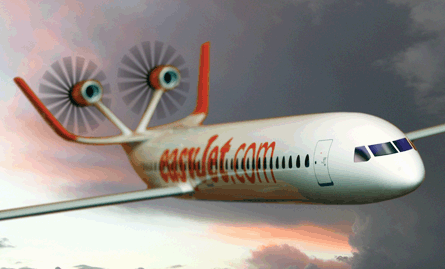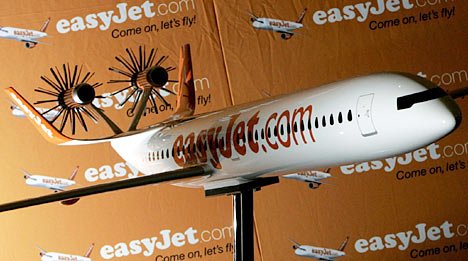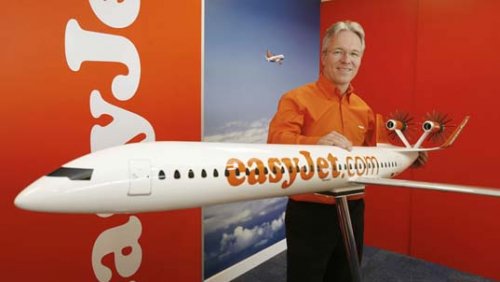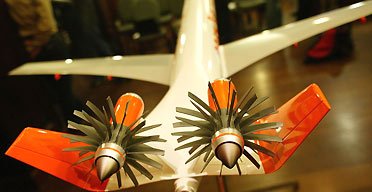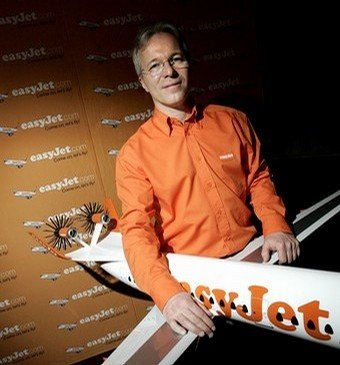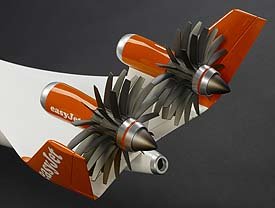British low-cost airline easyJet developed an environmentally-friendly aircraft in-house that resembles the New Aircraft Concepts REsearch (NACRE) Consortium Pro Green and Boeing "Fozzie" unducted fan environmentally-friendly passenger aircraft concepts.
easyJet ecoJet Press Release from 2007:
easyJet ecoJet Press Release from 2007:
http://www.easyjet.com/en/news/easyjet_ecojet.htmlThe “easyJet ecoJet”: to cut CO2 emissions by 50% by 2015
easyJet has today become the first airline to outline the environmental requirements that must be met by the next generation of short-haul super-clean aircraft; and unveiled its design of what such an aircraft could look like for operation by 2015.
Dubbed the “easyJet ecoJet”, the aircraft would need to be 25% quieter and would emit 50% less CO2 and 75% less NOx than today’s newest aircraft (the 737 and A320 families of aircraft).
The aircraft will incorporate the latest research by airframe and engine manufacturers around the world – all of which can be incorporated into an aircraft that should be in operation by 2015. The projection for the 50% CO2 reduction is based on the findings from the latest research by the industry leaders and will come from the engines (25%), the lightweight airframe (15%) and from improvements to air traffic control technology and design (10%).
In easyJet’s current configuration and operation, the projection for the eco-liner would generate less than 47g of CO2 per passenger km. For comparison, easyJet’s current operations generate 97.5g of CO2 per passenger km, the Toyota Prius emits 104g of CO2 per kilometre; and the European car industry has recently been given a target to achieve 130g of CO2 per kilometre.
The design will contain a number of key features to make it radically more environmentally efficient:
* Rear-mounted “open-rotor” engines offer unrivalled environmental performance for short-haul flying due to their higher propulsive efficiency. However, there are significant difficulties in fixing such a large engine under a wing of a narrow-body aircraft, making rear-mounting of the engines the optimum solution
* A lower design cruise speed to reduce drag and a shorter design range to reduce weight
* Noise reductions are expected to come from a gear box between the engine and the open-rotor blades keeping them subsonic during take-off and landing, the use of the rear empennage to shield the ground from engine noise, and airframe improvements (such as no slats on the front of the wing)
* The airframe will be made of advanced weight-reducing materials similar to those used in current projects like the Boeing 787, which itself is estimated to be 27% more fuel efficient than the aircraft it will replace in many fleets
Even as global demand for air travel matures over time, several step-changes in technology will be needed to reduce the emissions from aviation in 2050 to below 2005 levels. The “easyJet ecoJet” will be the first of these step changes and alone could lead to a stabilisation of emissions from short-haul aviation at 2005 levels until 2035 providing massive environmental benefits.
Speaking at a press conference to unveil the “easyJet ecoJet”, Andy Harrison, easyJet Chief Executive, said:
“The aviation industry has an excellent record in reducing the environmental footprint of aircraft. Today’s aircraft are typically 70% cleaner and 75% quieter than their 1960s counterparts. Now we are planning the next generation that will help towards taking the plane out of the emissions equation.
“easyJet is already setting the environmental standard in the airline industry. Our fleet of 131 aircraft has an average age of only 2.3 years – the youngest of any major airline in Europe. We have recently called for over 700 of the dirtiest aircraft to be banned from Europe’s skies and are active supporters of the EU’s Emissions Trading Scheme and Single European Skies programme.
“The aircraft example we have unveiled today represents the next major step forward in airframe and engine technology. The lightweight structure and open-rotor engines are based on technologies that are being developed right now by the major manufacturers. The “easyJet ecoJet” is realistic and it is achievable. If the “easyJet ecoJet” were to be made available today we would order hundreds them for fleet replacement and to achieve the ‘green growth’ that our industry has committed to.”

